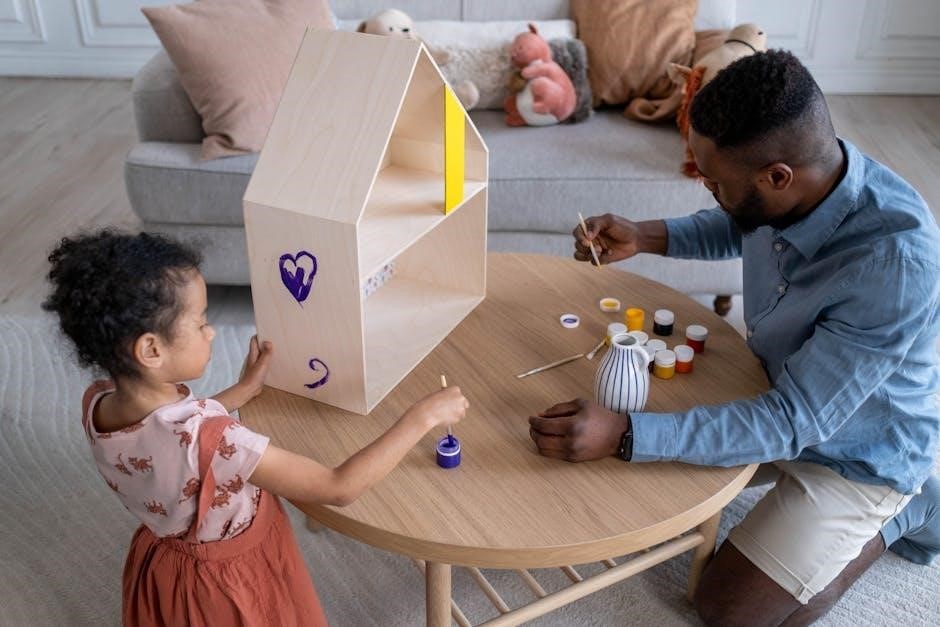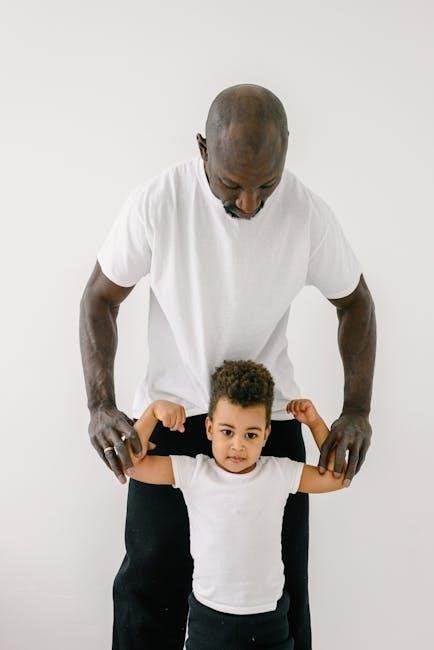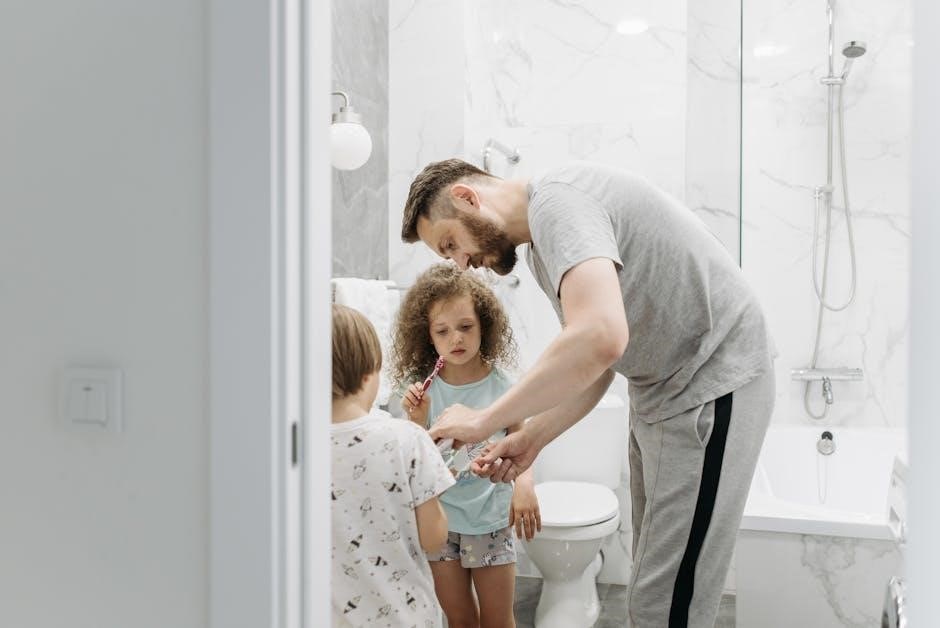
Addiction profoundly impacts family dynamics, creating distinct roles like the enabler, hero, and scapegoat. These roles often lead to codependency, reshaping relationships and emotional landscapes within the family structure.
Understanding the Concept of Family Roles
Family roles in addiction emerge as coping mechanisms within dysfunctional dynamics. These roles, such as the enabler, hero, scapegoat, mascot, and lost child, develop to manage stress and maintain balance. Each role serves a specific function, creating a structure that revolves around the addict. Over time, these roles become rigid and ingrained, often leading to unhealthy patterns of behavior and codependency. Understanding these roles is crucial for addressing addiction’s impact on family systems and fostering recovery.
The Impact of Addiction on Family Dynamics
Addiction disrupts family dynamics, creating an environment of stress, anxiety, and unpredictability. Family members often adopt maladaptive communication patterns, fostering secrecy and mistrust. The addict’s unpredictable moods and behaviors force others to adapt, leading to emotional strain and role shifts. This dysfunction can cause family relationships to become strained, with members struggling to maintain balance. Over time, the family system revolves around the addiction, exacerbating emotional and psychological distress. Understanding these dynamics is key to addressing the broader impact of addiction on families.

The Role of the Addict
The addict’s behavior becomes the central focus of the family, creating a cycle of dependency and dysfunction. Their actions often dictate the emotional and relational dynamics.
How Addiction Becomes the Central Focus
Addiction often becomes the central focus of family life, as the addict’s unpredictable behavior and needs dominate daily routines. Family members adapt to the addict’s habits, creating a cycle where their actions revolve around managing or enabling the addiction. This dynamic shifts the family’s emotional and relational energy, making the addict’s struggles the primary concern. Over time, the family’s identity and interactions become deeply intertwined with the addiction, fostering a dysfunctional environment where other roles and responsibilities are overshadowed by the addict’s behavior.
The Emotional and Psychological Toll on the Addict
Addiction takes a profound emotional and psychological toll on the addict, often leading to feelings of guilt, shame, and isolation. The constant struggle with substance use creates internal conflict, exacerbating mental health issues like anxiety and depression. Over time, the addict may lose their sense of identity and purpose, becoming increasingly dependent on the substance to cope with emotional pain. This cycle erodes self-esteem and fosters a deep-seated fear of failure, further entrenching the addiction and making recovery more challenging.
The Addict’s Influence on Family Dynamics
The addict’s behavior significantly disrupts family dynamics, creating an environment of unpredictability and tension. Family members often adjust their actions to avoid triggering the addict, leading to a loss of normalcy and emotional balance. Roles within the family become distorted, as others may take on responsibilities the addict neglects, fostering resentment and enabling behaviors. This imbalance can lead to emotional withdrawal and strained relationships, making it difficult for the family to function cohesively and healthily, further complicating the recovery process for both the addict and the family unit.

The Enabler
The Enabler’s role involves unintentionally supporting the addict’s behavior, often through well-meaning actions. This creates an unhealthy dynamic, enabling continued substance use and hindering recovery efforts.
Defining the Enabler’s Role
The Enabler is a family member who unintentionally supports the addict’s behavior, often by covering up for their actions or providing financial support. This role stems from a desire to avoid conflict or protect the addict, but it perpetuates addiction by removing consequences. Enablers may feel responsible for the addict’s well-being, leading to sacrificing their own needs. Their actions, though well-intentioned, create an unhealthy dynamic that prevents the addict from facing reality. This role is central to the cycle of addiction, as it shields the addict from accountability and hinders recovery efforts.
How Enabling Behaviors Perpetuate Addiction
Enabling behaviors, such as covering up for the addict or providing financial support, remove the negative consequences of addiction. This creates a cycle where the addict feels no urgency to change. By shielding the addict from accountability, enablers unintentionally sustain the addiction. These actions prevent the addict from experiencing the full impact of their choices, delaying potential recovery. Over time, enabling behaviors reinforce the addict’s dependence, making it harder for them to seek help and fostering a dysfunctional family environment that supports addiction rather than recovery.
The Emotional Consequences for the Enabler
Enablers often experience emotional exhaustion, guilt, and resentment as they constantly prioritize the addict’s needs over their own. Over time, this can lead to feelings of helplessness and burnout. The enabler may also struggle with anxiety and depression, as they internalize the stress of managing the addict’s behavior. Their self-worth can become tied to the addict’s recovery, creating a cycle of emotional dependency. Neglecting personal boundaries and needs, enablers may lose their sense of identity, further complicating their emotional well-being and relationships within the family.

The Hero
The hero often emerges as the overachiever, compensating for family dysfunction by excelling in various areas. This role provides a sense of balance but can lead to emotional suppression.
Characteristics of the Hero Role
The hero role is characterized by overachievement and a need for control. Heroes often excel academically, socially, or athletically to compensate for family dysfunction. They may appear resilient but internally struggle with stress and pressure to maintain their image. This role often leads to emotional suppression and an avoidance of vulnerability, as heroes focus on maintaining stability rather than addressing their own emotional needs. Their efforts to balance the family dynamics can prevent them from seeking help for their own struggles.
How the Hero Compensates for Family Dysfunction
The hero compensates for family dysfunction through overachievement and perfectionism. They often excel in school, sports, or extracurricular activities to gain approval and stability. By succeeding, heroes divert attention from the addict and other family issues, creating a sense of control and normalcy. This behavior helps the family avoid addressing the addiction directly, allowing the dysfunctional dynamics to persist. While the hero’s efforts provide temporary relief, they also mask underlying emotional pain and prevent the family from confronting the root causes of their struggles.
The Long-Term Effects of the Hero Role
The hero role often leads to emotional strain and mental health challenges. Heroes may develop anxiety or depression due to the pressure of maintaining a perfect image. Over time, they may struggle with intimacy, as their focus on control and achievement hinders vulnerability. Burnout is common, as the hero bears the weight of family dysfunction without support. This role can also foster resentment and feelings of isolation, as the hero’s sacrifices go unrecognized. Ultimately, the hero’s long-term well-being may suffer due to the unresolved emotional toll of their responsibilities.
The Scapegoat
The scapegoat is often blamed for family dysfunction, becoming a target for others’ frustrations. This role can lead to low self-esteem, emotional distress, and feelings of alienation, while also increasing the risk of mental health issues or rebellious behavior as a coping mechanism.
Understanding the Scapegoat’s Role
The scapegoat emerges as a target for family members to shift blame and frustration, often due to unresolved tensions or the addict’s behavior. This role is assigned to someone perceived as vulnerable or different, creating a dynamic where their actions are overly scrutinized. The scapegoat may internalize guilt, develop low self-esteem, or act out in rebellion. This role distracts from addressing the addiction directly and perpetuates dysfunctional family dynamics, allowing the addict’s behavior to remain unchallenged while the scapegoat bears the emotional burden.
How the Scapegoat is Affected by Family Dynamics
Family dynamics in addiction often lead to the scapegoat being emotionally isolated and blamed for the family’s dysfunction. This role forces them to bear the brunt of unresolved tensions, fostering feelings of resentment and low self-worth. The scapegoat may struggle with identity and develop behavioral issues as a coping mechanism. Constant criticism and lack of support can lead to long-term psychological effects, such as anxiety or depression, making it challenging for them to form healthy relationships outside the family environment.
The Scapegoat’s Struggle with Identity
The scapegoat often grapples with a distorted sense of self due to being blamed for the family’s problems. This role fosters feelings of inadequacy and low self-worth, as they are consistently criticized and invalidated. Over time, the scapegoat may struggle to develop a healthy identity, as their worth is tied to the family’s dysfunction. They may rebel or internalize the negativity, leading to self-esteem issues and difficulty forming positive relationships. This struggle with identity can persist beyond childhood, affecting their ability to trust others and find their true self.

The Mascot
The mascot uses humor and charm to distract from family pain, often masking their own emotional struggles. This role provides temporary relief but may hide deeper issues.
Defining the Mascot’s Role
The mascot is often the family member who uses humor and charm to lighten the mood, diverting attention from the addiction. They may act as the “class clown,” creating a sense of normalcy. This role involves coping with stress through humor, attempting to maintain harmony. The mascot’s behavior is a way to avoid conflict and emotional pain, but it can also mask their own struggles, leading to unaddressed mental health issues. This role is both a survival mechanism and a potential source of hidden distress.
How the Mascot Copes with Family Stress
The mascot copes with family stress by using humor, charm, and positivity to create a distraction from the addiction. They often act as the “light-hearted” figure, making jokes or avoiding serious discussions to maintain a sense of normalcy. This role involves redirecting attention away from conflict and emotional pain, helping the family avoid confrontation. By focusing on being the “fun” family member, the mascot attempts to reduce tension and maintain harmony, though this can mask their own emotional struggles and prevent them from addressing their needs.
The Mascot’s Risk of Developing Mental Health Issues
The mascot often hides their true feelings behind humor and positivity, which can lead to suppressed emotions and mental health struggles. This role may result in anxiety or depression as they internalize their pain. Their need to maintain a cheerful facade can prevent them from seeking help, increasing the risk of emotional burnout. Over time, the mascot may develop low self-esteem or struggle with identity, as their value is tied to their ability to uplift others rather than addressing their own needs.

The Lost Child
The lost child often withdraws from family interactions, seeking isolation to cope with dysfunction. This role leads to emotional neglect, as the child feels unseen and unimportant.
Characteristics of the Lost Child Role
The lost child role is characterized by withdrawal and invisibility within the family. They often avoid conflict and emotional engagement, becoming detached to survive the dysfunction. This role involves suppressing emotions and needs, leading to feelings of isolation. The lost child may appear independent but struggles internally with identity and self-worth. Their silence and avoidance serve as coping mechanisms, though they risk long-term emotional and psychological challenges, including difficulty forming healthy relationships and achieving personal growth.
How the Lost Child Adapts to Family Dysfunction
The lost child adapts to family dysfunction by withdrawing and becoming emotionally detached. They often avoid conflict and emotional engagement, focusing on self-reliance to minimize stress. This role involves suppressing personal needs and feelings, leading to isolation. The lost child may appear indifferent to family issues, using avoidance as a coping mechanism. While this helps them navigate the dysfunction, it can result in long-term emotional challenges, such as difficulty forming intimate relationships and understanding their own identity.
The Emotional Isolation of the Lost Child
The lost child often experiences profound emotional isolation, feeling disconnected from both themselves and others. This isolation stems from their withdrawal as a coping mechanism, leading to a lack of emotional expression and intimacy. They may struggle to identify their own feelings, developing a sense of detachment that can persist into adulthood. This emotional distance not only affects their personal relationships but also hinders their ability to seek support, exacerbating their sense of loneliness and disconnection from the world around them.
Family Roles and Codependency
Family roles often create a cycle of dependency, enabling addictive behaviors and fostering emotional reliance. This dynamic can perpetuate unhealthy patterns, affecting all members psychologically and emotionally.
How Family Roles Lead to Codependency
Family roles in addiction often create a cycle of dependency, where members enable or compensate for the addict’s behavior. This leads to codependency, as individuals become emotionally reliant on each other for validation and support. The enabler, for instance, may constantly rescue the addict, while the hero overachieves to compensate for the family’s dysfunction. These roles blur healthy boundaries, fostering a toxic environment where emotional needs are neglected, and addictive behaviors are inadvertently reinforced. Codependency becomes a shared coping mechanism, perpetuating the cycle of addiction and dysfunction within the family system.
The Role of Codependency in Addiction
Codependency plays a central role in addiction by creating an enabling environment where the addict’s behavior is tolerated or inadvertently encouraged. Family members often prioritize the addict’s needs over their own, fostering an unhealthy reliance. This dynamic can prevent the addict from facing consequences, hindering recovery. Codependency also perpetuates emotional dysfunction, as individuals struggle with self-worth and boundaries. By maintaining this cycle, codependency deepens the addiction’s grip, making it harder for both the addict and the family to break free and seek healthier patterns of interaction and support.
Breaking the Cycle of Codependency
Breaking the cycle of codependency requires setting healthy boundaries and seeking therapy. Family members must shift from enabling behaviors to encouraging accountability, fostering an environment where the addict can take responsibility for their actions. Professional guidance, such as family therapy, helps individuals recognize and change maladaptive patterns. Support groups like Al-Anon also provide tools for loved ones to focus on their own well-being. By addressing codependency, families can promote healthier dynamics, empowering both the addict and themselves to pursue recovery and emotional healing.

Impact of Addiction on Family Communication
Addiction distorts family communication, fostering secrecy and enabling behaviors, which hinder honest dialogue and prevent effective addressing of the addiction, leading to emotional isolation.
Maladaptive Communication Patterns
Addiction disrupts family communication, fostering unhealthy patterns like secrecy, blaming, and emotional suppression. Family members may avoid discussing the addiction, leading to emotional distance. This avoidance prevents honest dialogue and stifles opportunities for addressing the issue constructively. The addict’s unpredictable behavior often creates a volatile environment, where open communication is replaced with defensiveness or silence. Over time, these maladaptive patterns reinforce the addiction, making it harder for the family to confront the problem and work toward recovery together. These dynamics further isolate individuals, deepening the emotional toll of addiction;
The Role of Secrecy in Addiction
Secrecy often surrounds addiction, becoming a protective mechanism for the family. Family members may hide the addict’s behavior to shield the family image or avoid stigma. This secrecy isolates the addict, preventing open discussion about the issue. It creates emotional barriers, making it difficult for the addict to seek help. Secrecy also prevents outside intervention, allowing the addiction to escalate. Over time, this silence reinforces the addiction, fostering a cycle of concealment and enabling. The family’s collective secrecy further entrenches the problem, making recovery more challenging for both the addict and the family.
Improving Communication in Recovery
Effective communication is crucial for recovery. Families must break down barriers of secrecy and mistrust, fostering open dialogue. Honest expression of feelings and concerns helps rebuild connections. Active listening and empathy create a supportive environment, encouraging the addict to share their struggles. Setting boundaries while maintaining compassion ensures accountability without enabling. Professional guidance, such as family therapy, can provide tools to navigate these conversations constructively. Improved communication strengthens the family system, aiding recovery and promoting long-term healing. It requires effort and commitment from all members to establish a foundation of trust and understanding.
Family Dynamics and Addiction Recovery
Family dynamics play a crucial role in addiction recovery by fostering support and understanding. Through therapy, families address dysfunctional patterns and work together toward healing.
The Role of Family in Recovery
The family plays a vital role in addiction recovery by providing emotional support and fostering a nurturing environment. Education about addiction helps family members empathize and understand the recovery process. Active involvement in therapy sessions strengthens bonds and promotes healing. Families can encourage healthy habits, such as regular routines and open communication, which aid in sustaining sobriety. Their unwavering support and compassion create a foundation for the addict to rebuild their life, emphasizing the importance of collective effort in overcoming addiction.
Family Therapy Approaches
Family therapy approaches address addiction by identifying and restructuring dysfunctional dynamics. Techniques like cognitive-behavioral therapy and systems theory help families understand their roles in addiction. Therapists guide families to develop healthier communication patterns and set boundaries. Family therapy also focuses on rebuilding trust and fostering empathy among members. By addressing underlying issues and promoting mutual support, these approaches create a stable environment conducive to long-term recovery and personal growth for both the addict and their loved ones.
Rebuilding Trust in Recovery
Rebuilding trust in recovery requires consistent effort from all family members. Open communication and honesty are essential to repair relationships strained by addiction. Setting clear boundaries and following through on commitments helps restore credibility. Family therapy provides a safe space for addressing past hurts and fostering accountability. As trust grows, family dynamics shift from suspicion to support, creating a foundation for lasting healing and recovery. Patience and understanding are vital during this process, as trust is rebuilt gradually over time.

Prevention and Support Strategies
Education on addiction, therapy, and community support are key strategies. Empowering families through awareness and resources helps prevent addiction and fosters recovery. Promoting healthy communication and coping mechanisms strengthens family bonds and resilience, reducing the risk of relapse and fostering long-term healing.
Role of Family in Prevention
Families play a crucial role in preventing addiction by fostering open communication and healthy coping mechanisms. Education about substance abuse and its effects empowers family members to recognize early warning signs. Establishing clear boundaries and providing emotional support creates a protective environment. Families can also encourage positive behaviors and seek professional help when needed, helping to prevent addiction before it begins. By promoting a supportive and informed home environment, families can significantly reduce the risk of substance abuse among their members.
Support Systems for Families
Support systems for families affected by addiction include counseling, therapy, and peer support groups like Al-Anon and Nar-Anon. These resources help family members understand the disease of addiction and develop healthy coping strategies. Professional counseling can address emotional trauma and improve communication patterns, fostering a more supportive environment for recovery. Additionally, community programs and educational workshops provide practical tools for navigating the challenges of addiction. By engaging with these support systems, families can rebuild their dynamics and promote long-term healing and resilience.
Resources for Families Affected by Addiction
Resources for families include therapy, support groups, and educational materials. Professional counseling and programs like Al-Anon provide guidance and community. Online forums and helplines offer immediate support, while books and workshops educate families on addiction’s impact. These resources help families navigate their roles, fostering understanding and healthier dynamics. They also emphasize the importance of self-care and seeking help, enabling families to support their loved ones while maintaining their own well-being during the recovery process.
Leave a Reply
You must be logged in to post a comment.